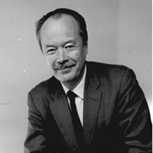Kinsey Institute Directors
Dr. Justin Garcia
Executive Director, 2019-Current
Dr. Justin Garcia was appointed Acting Executive Director in July 2019, during a period of transition and consolidation. The institute continued its move out of Morrison Hall, and finalized various projects that had been under development in previous years, including the launch of a brand new online sex education initiative, and transferring the Special Collections to the IU Libraries ALF facilities.
In 2020, Dr. Garcia was appointed Executive Director. The beginning of his direction of the institute was marked by the worldwide Coronavirus pandemic, when the Kinsey Institute pivoted quickly to launch a dedicated COVID-19 research program and provide information and guidance about the impact of the disease on sex and relationships. The Institute also launched new online outreach initiatives including a social media campaign featuring items from the Special Collections on Instagram and Facebook, an online symposium on censorship and obscenity, and a new online format for the Kinsey Institute Discussion Series.
More about Dr. GarciaDr. Alfred C. Kinsey
Founding Director 1947-1956
Dr. Kinsey built the foundation of research and collection of sexuality-related resources that became the Institute for Sex Research in 1947. He oversaw data collection and publication of the ground-breaking volumes, Sexual Behavior in the Human Male (1948) and Sexual Behavior in the Human Female (1953) - known as the 'Kinsey Reports' - before his untimely death in 1956.
Read more about Dr. Kinsey.
See Staff Publications for the list of articles, books, and book chapters published during the Kinsey era.
The Post-Kinsey Era
Since 1957, the Kinsey Institute has had seven directors—each bringing new focus and vision to the study of sexuality, relationships, gender, reproduction, and love.
After Kinsey's death in 1956, direction of the institute was initially split between Dr. Paul Gebhard as executive director and Dr. Wardell Pomeroy as director of field research. Following Dr. Gebhard, direction of the institute has been centered in the executive director.

Paul H. Gebhard
Director 1956-1982
Dr. Paul Gebhard, a Harvard trained anthropologist who joined the team in 1947, took over as executive director after Kinsey's untimely death. The ISR faced several difficulties at the time, including a protracted and expensive legal battle with U.S. Customs, the need to find new sources of funding, and several incomplete projects. Over the next 25 years, Gebhard succeeded in opening the institute's doors to scholars around the world, making it a leading resource center for those interested in all facets of human sexuality.
See Staff Publications for the list of articles, books, and book chapters published during the Gebhard era.

June M. Reinisch
Director 1982-1993
Dr. June Reinisch, a psychologist from Columbia University, was appointed director after Gebhard’s retirement. Under her directorship, the institute—which was renamed Kinsey Institute for Research in Sex, Gender, and Reproduction—expanded its vision and broadened its public impact. It also found its fourth home at Morrison Hall on the IU Bloomington campus. By 1990, the Kinsey Institute had grown enough to launch the first full cataloguing and exhibition of art collections.
See Staff Publications for the list of articles, books, and book chapters published during the Reinisch era.

Stephanie A. Sanders
Interim Director 1993-1995 and 2013-2014
Dr. Stephanie Sanders, who joined the institute as a researcher in 1982, served as interim director for two years in 1993-1995 and again for one year in 2013-2104. Visit Dr. Sanders' profile to learn more about her research at the Kinsey Institute and beyond.
See Staff Publications for the list of articles, books, and book chapters published during the first Sanders era.

John J. Bancroft, MD
Director 1995-2004
Dr. John Bancroft is the first and only medical doctor to serve as executive director. During his tenure, the Kinsey Institute stepped into clinical research, as well as the digital age. Bancroft also drove the institute to reflect on its mission and its original publications with celebrations of the 50th anniversaries of Sexual Behavior in the Human Male and Sexual Behavior in the Human Female. Institute staff also expanded their impact during this period by hosting symposiums, numerous art exhibits, and public facility tours.
See Staff Publications for the list of articles, books, and book chapters published during the Bancroft era.

Julia Heiman, Ph.D.
Director 2004-2013
Dr. Julia Heiman’s tenure saw significant growth in research and the collections. Under her guidance, institute researchers produced findings on a number of topics, including: arousal response in bisexual men; sexual satisfaction & relationship happiness in midlife couples; infidelity in heterosexual couples; the effects of hormonal contraceptives on women's sexual experience, and effective condom fit. The institute also hosted a number of art exhibitions and established the Kinsey Institute Juried Art Show.
See Staff Publications for the list of articles, books, and book chapters published during the Heiman era.

C. Sue Carter, Ph.D.
Director 2014-2019
A career biologist, Carter has studied the endocrinology of love and social bonds for more than three decades and is the first person to detect and define the physiology of monogamy through her research on the prairie vole. During her directorship, the Kinsey Institute expanded its research to examine sexuality and intimacy within the dynamics of relationships. She established the Kinsey Institute Traumatic Stress Research Consortium which is is pioneering collaborative research with clinicians on long-term changes to physiology, physical health, and emotional wellbeing in the aftermath of trauma. Following a serious water pipe break in 2016 in the Institute's home in Morrison Hall, a massive undertaking began to transfer the Kinsey Institute Special Collections to the new Indiana University Libraries Auxiliary Library Storage Facilities (ALF). Dr. Carter also spearheaded the Travelling Exhibitions Program which collaborated with national and international museums and galleries to exhibit Kinsey Institute archival and art items for audiences worldwide.
See Staff Publications for the list of articles, books, and book chapters published during the Carter era.
More Resources
Support Kinsey
Sexuality and intimate relationships are essential to our individual and collective well-being. Your support will help the Kinsey Institute advance research and education in the science of love, sexuality, gender, and sexual health, and give our diverse field of researchers the resources they need to make new discoveries.
Pledge your support
